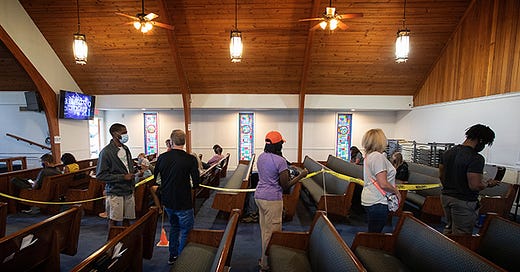Long Live the Past
I was an early subject for the polio vaccine. My father had a lab at the University of Michigan down the hall from Jonas Salk. Polio scared so many, almost anyone would have asked to have a chance at the earliest possible dose.
Years later, I remember standing in a line at a Public Health building to get a shot. As a child, I remember nothing about it except the wait in line and the sudden jab. But the lines were long and people rushed to get whatever they could to protect them. Some were seniors who remembered the deadly flu; others simply knew that there were some bad bugs out there and wanted to try any option to protect themselves. They also wanted to be part of a community that was fully immunized, protecting every citizen, not just themselves.
When I was a grad student/teaching assistant at the University of Michigan, the swine flu hit the country. A vaccine for the flu was mandated for all employees, including me. But like the flu vaccine (until relatively recently), all these were incubated in eggs, which meant for those allergic to egg, the vaccine was deadly. I remember feeling bad that I couldn’t do my part, but heartened that most in Ann Arbor got their stick. For those who don’t remember, some people fell ill with Guillane-Barre syndrome, an ascending paralysis. Still, most felt it worth the risk to get vaccinated.
Today’s Story
We have great treatments and vaccines for a lot of illnesses that beset people my age. We’ve got treatments for so many things, that only a few scary monsters of disease truly worry us. Complacence has set it. It won’t be me. It won’t happen to someone I love. But it might.
I don’t know the reason for the hesitancy. If we had taken the normal, killed-virus approach, we’d still be years short of a vaccine. But the mRNA technology which has taken the world by storm for a variety of maladies, including vaccines for cancer, empowered drug companies to create vaccines within four days of getting the virus samples from China. Testing was hurried, but in the past eight months and with millions getting the vaccine, this is more testing than had ever been done with any drug. Vaccines aren’t perfect, but given the deaths and long-haul cases, wouldn’t most people opt to try it?
Apparently not. While most anti-vaxxers in California were liberals, conservatives have been targeted as the most resistant group. Politics has reared its ugly head in what should just be a public health issue, and caused many to take their chances. The problem is, it isn’t just your body. If you get the CCP virus, you may/will infect others. Some people have medical issues and can’t take the vaccine, though I don’t think there a lot of them. We’re still short of where we need to be, and as the virus mutates, we may need boosters and slightly altered vaccines.
Two Approaches
Since late January, the government has taken the position of coercion to get more to get the vaccine. Proof of vaccination is required in many places, or you can’t get in. Threats are being made. Conservatives are being blamed, and yet, those I know are mostly vaccinated.
One thing I learned in problem resolution is to start with modest and conciliatory approaches first. You can always “up the game” if needed. And you also start by understanding the problem. We’ve clearly skipped this step. When people are afraid of authorities, which many groups are, you have to work with that fear. Some success has been achieved in majority-Black churches when the minister rolls up his arm and gets the shot, inviting others to join him at a church-hosted event. We have to look at the core fear/problem people have with the injection and within groups with similar concerns, figure out how to encourage them. Money doesn’t work; too many governors have tried to bribe people. That’s a costly and useless experiment.
After 9/11, we saw a country united by fear and anger. At that time, had we been hit with a biological warfare attack, few would have shunned a treatment. Even the young would want to protect their older family members. But we’re divided now, and increasingly angry about that divide. We’ve forgotten how to live as community members, inspired to see our roles and responsibility to that community. What would have happened if we had simply asked people to look around and ask, “Which of your family members could you live without? Whose life are you willing to risk by possibly getting ill yourself and spreading it? Would you be okay if you knew that a visit to a relative at their assisted living center ended up killing other seniors?”
We should be thinking beyond ourselves. This won’t work for everyone, but I have seen it in a far less critical instance. At Trader Joe’s months ago, they had a small shipment of toilet paper. The packages sat next to an employee and he urged people just to take one. At the register, people buying more than one of a needed product were asked to consider putting some of their purchases back. I never saw a single person refuse. For that moment in time, people thought to look outside themselves and consider their neighbors.
People may have really well-considered reasons not to get vaccinated. Not everyone needs to be vaccinated. But consider this an appeal to your compassion and community spirit. Think about it just one more time. This disease is not really as fatal as some, but given the impact on our lives, it’s worth another appeal for cooperation.




